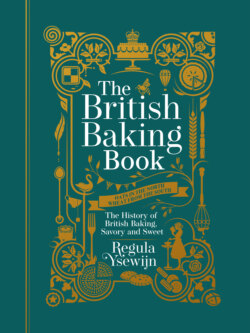Читать книгу The British Baking Book - Regula Ysewijn - Страница 9
На сайте Литреса книга снята с продажи.
Оглавление12
While in French pâtisserie the expertise lies with the pastry chef and pastries are usually bought in a pâtisserie, British people bake
at home. The uniqueness of their baked goods has something to do with that. Scones taste best when they have just come out of the
oven and are still steaming when you break them open. If you offer simple, modest bakes, you ensure that the taste is 100 percent
spot on. You cannot hide behind cheerful colors and delicate frills. I often find with French cakes that they look far better than they
actually taste, and wonder about the amount of gelatin and food coloring needed to get the “perfect” look.
British baking is coziness and warmth. The British make time for cakes. If they could, they would drop everything each day at
four o’clock for afternoon tea. Recently a police notice showed a picture of some goods they wanted to trace the ownership of
and in the background was a plate with a half-eaten Victoria sandwich cake. All the comments on the picture were about the cake,
not the police notice! Cakes, biscuits, pies, and other sweet and savory pastries are entwined with the identity of the inhabitants
of the green British Isles. It is not surprising that the baking program The Great British Bake Off is a British invention, and I often
pinch myself when I stand in that iconic white tent, trying to fill Mary Berry’s shoes. For the British, a village fair is not complete
without a baking competition. Baking and competitions for the best cake, biscuit, jam, or biggest gooseberry are an important
community happening and a pinnacle of Britishness.
The day before our wedding in Britain we encountered such a village fair. We were too early for the baking competition, but on the
lawn next to the white tent a coquettish lady was sitting behind a table with a large fruit cake, of which you had to guess the weight.
My guess was completely wrong, but when the lady heard that we were getting married in her village, she gave me the first prize.
“British baking is coziness and warmth.”
Authenticity
I developed the recipes in this book based on those I encountered during my historical research – not as straightforward as you
might think, since recipes were not explained as extensively in the past as they are today. Ingredients were often left out on the
assumption that the cook would know what was required. For example, one recipe for a tart gave the ingredients and method for
the filling, but did not reveal anything about the dough for the base. Guidelines for assessing the doneness of a cake were omitted,
as well as the preparation times and oven temperatures. The ingredients were also different. Eggs are much larger nowadays and
flour is a lot finer. The recipes needed countless tests to bring them to what they are today.
I deliberately did not make a pimped-up version of the British bakes because it would be arrogant to drastically change anything
in a book that is trying to paint a picture of the history of British baking. For example, if I gave a Chelsea bun a twist by adding
pistachios or pecans, leaving out the currants, it would no longer be a Chelsea bun. It would be good, but it would no longer be
that iconic, slightly square, rolled-up sticky bun, dotted with currants and dusted with fine sugar.
When it comes to more recent classics such as carrot cake, coffee and walnut cake, lemon drizzle, flapjacks, and a few pies,
I have given you the recipes that I have been baking for years. Often these are based on memories of what I ate in Britain on my
many travels over the last two decades.
My many historical cookbooks and diaries tell a story about the origin and evolution of flavors and thus about the evolution
of a recipe due to changes in cooking methods. Delicately rich pastries and confectionery were the privilege of the higher class.
From the Victorian era, there were also books for the working class. The new generation of cookbooks “for the people,” as the
19th-century chef Alexis Soyer wrote on the cover of his book, were written with the home baker in mind. This was not always
realistic, since many people of the lower classes lived in houses without kitchens.
Many manuals for bakers were published around the 20th century. Confectioners who made delicate sweet treats disappeared
from the stage as the parties in large houses became less decadent and there were fewer and fewer domestic workers who could
spend hours creating a lavish feast. The bakery continued to exist, and took over part of the repertoire from the confectionery,
